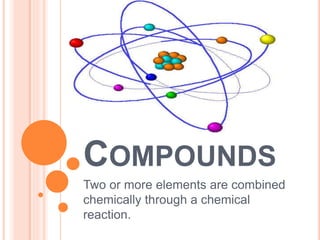
Compounds/Mixture/Atomic Model
- 1. COMPOUNDS Two or more elements are combined chemically through a chemical reaction.
- 2. Compounds are govern by the law of definite proportion proposed by Joseph Proust in 1799. This states that a pure compound always consist of the same elements combined in the same proportion by mass.
- 3. Water is always formed by the elements of hydrogen and oxygen in the proportion 11.9% hydrogen and 88.81% oxygen
- 4. A chemical formula is used as a quick way to show the composition of compounds. Letters, numbers, and solid are used to represent elements and the number of elements in each compound. H2O- water NaCl- salt C12H22O11-sugar
- 5. Compounds can be classified into acids, bases, and salts. To be able to distinguish one from the other, you need to use indicators. Indicators- are substances whose color are affected by acids and bases. An example is the litmus paper. Acid change a blue litmus paper to red. Base change a red litmus paper to blue. Salt do not affect the indicators
- 7. COMPOUNDS IN OUR DAILY ACTIVITIES Shampoo Conditioner Bath soap Vinegar or acetic acid Vetsin or monosodium glutamate Salt or sodium chloride Muriatic acid or hydrochloric acid There are some acid and bases that are corrosive due to their acidity and basicity.
- 9. MIXTURES An element or a compound is a pure substance. All other kind of matter is mixture. Mixture are composed of two or more substances that are mixed together physically.
- 12. Homogeneous mixture –there is the same proportion of components throughout the mixture It is also called solution.
- 14. ATOMIC MODELS
- 15. DALTON’S ATOMIC THEORY (THE SOLID SPHERE MODEL) John Dalton(1766-1844), an English physicist and chemist, proposed his atomic theory of matter in 1803. Hi pictured atom as solid, indestructible sphere with a mass that is like a billiard ball.
- 16. JOSEPH JOHN THOMSON (THE RAISIN BUN MODEL) J.J. Thomson (1856-1940)-, a British physicist, was able to discover negatively charged particles known electron using cathode ray tube. It may also be similar to a cookie and chips in it._
- 17. ERNEST RUTHERFORD (NUCLEAR MODEL OF AN ATOM) Rutherford’s atomic model bears a resemblance to a miniature solar system, with positively charged nucleus at the center, and the electron revolving around the nucleus. Due to discovery of nucleus his work also known as Nuclear Model of an Atom.
- 19. NEILS BOHR (PLANETARY MODEL OF AN ATOM)
- 21. SUBATOMIC PARTICLES Atoms are best described through different atomic models. Atoms are primarily made of three sub-particles-proton, electron, and neutron
- 23. ATOMIC NUMBER AND MASS Ion- is called to a charged particles Cation- the ion with positive charge formed when electron is removed from an atom. Anion-the ion with negative charge, is formed when the electron is added to an atom.
- 24. Atomic Number- “Numeric Identity “of the Element. distinctive number of protons and also represents the number of electrons.
- 25. Mass number- the mass of an atom is based on the weight of protons and neutrons in the nucleus. Isotopes- are atoms in the same element with the atomic number but differ in atomic mass Nuclide- an atom of a specific isotope
- 26. For neutral atom, Number of protons = number of electron= atomic number(Z) Mass number (A) = number of Protons + Number of neutrons Number of neutrons = atomic number (Z) – mass number
- 28. Practice exercise Page 271
